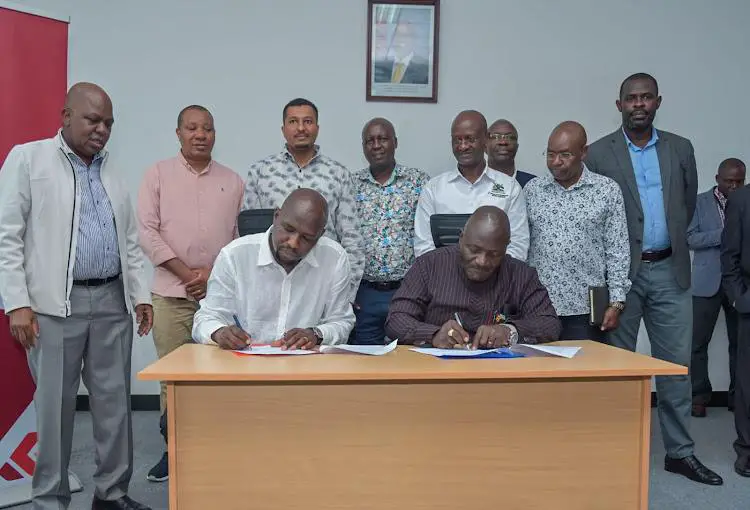- Kenya and Uganda agree to add 2,746 kilometers to the SGR, increasing overall cost of the project to over $19.4 billion.
- SGR extension is part of the larger $24.1 billion Lamu Port South Sudan-Ethiopia Transport (Lapsset) plan.
- Uganda will extend the SGR to its border with Rwanda, South Sudan, and the DRC.
Kenya and Uganda have jointly signed a communique on SGR extension financing, paving the way for an ambitious infrastructure project connecting the two economies. The initiative will guide the development of two significant railway projects, the Naivasha-Kisumu-Malaba and the Malaba-Kampala Standard Gauge Railway (SGR) links. Once the SGR extension financing is secured, the projects will be implemented in the respective countries.
The deal was formalized with the presence of Kenya’s Transport minister Kipchumba Murkomen and his Ugandan counterpart Edward Katumba-Wamala.
While Kenya has already signed commercial contracts for its SGR sections, Uganda is on track to finalize the contract for the Malaba-Kampala link. Both governments are actively working on mobilizing funds for these railway projects.
Previously, the two nations had planned on joint financing, but faced considerable delays. Now, they are choosing to independently pursue financing for their respective SGR sections. Already, Kenya is expressing its desire to seek funding for the Naivasha-Kisumu-Malaba SGR section.
The ministers emphasized the importance of synchronizing the construction of the railway projects to ensure their viability and successful completion. “The government of Kenya is desirous to submit an application for financing for the Naivasha-Kisumu-Malaba SGR section,” the ministers said.
Regional integration through railway
They acknowledged that developing the railway will yield substantial benefits, particularly in reducing transportation costs for business. The project will be carried out as a regional endeavor under the Northern Corridor Integration Projects Initiative.
To enhance connectivity and attract SGR extension financing, the governments pledged to construct the Naivasha-Kisumu-Malaba and Malaba-Kampala sections concurrently. They also committed to expediting the process of securing financing for the SGR sections.
Murkomen and Wamala additionally agreed to address any challenges that might hinder financing and impact the projects negatively. They agreed there is a need of reaching out to neighboring countries Rwanda, South Sudan, DRC, and Burundi.
Uganda is taking the initiative to extend the SGR to its border with Rwanda, South Sudan, and DRC to improve viability and attract financing along the Northern Corridor.
The statement clarified that Uganda would apply for financing for the SGR Western Route (Kampala-Kasese-Mpondwe with a branch line from Bihanga-Mirama Hills) immediately after securing financing for the SGR Eastern route from Malaba-Kampala.
Both countries have pledged to coordinate their construction plans for the remaining sections of the SGR and prioritize the timeline for resource mobilization to ensure smooth progress and successful completion of the projects.
Reviving talks on expansion
In May, Kenya embarked on an ambitious plan to extend the SGR to Kisumu, Malaba, and Isiolo by June 2027. The undertaking is projected to cost $14.8 billion. This new development will add 2,746 kilometers to the SGR, increasing the overall expenditure on the railway project to over $19.4 billion.
The expansion project is derived from the Jubilee Government’s signature Mombasa-Nairobi SGR, which turned to be Kenya’s most costly initiative.
This effort is part of the larger $24.1 billion Lamu Port South Sudan-Ethiopia Transport (Lapsset) plan, which aims to transform transportation and revamp trade Kenya’s north.
The comprehensive scheme intends to facilitate movement within Kenya, South Sudan, and Ethiopia. Its scope extends not only to the border town of Malaba via Kisumu but also includes Isiolo, Moyale, and the island of Lamu.
The SGR concept inception
In 2014, Kenya entered into a tripartite agreement with Rwanda and Uganda to construct a SGR from Mombasa through Kampala to Kigali. However, the SGR ended abruptly in Naivasha with China reportedly declining to finance the last leg of the project. Media reports say China failed to strike a financing agreement with Uganda.
With the latest initiative, it appears President William Ruto has rekindled plans to complete finally extend SGR.
Early this year, Mr Murkomen said Kenya will extend the SGR from Naivasha to her border with Uganda. The minister said the project will be through a five-year plan that will see the SGR snake through Narok, Bomet, Nyamira, Kisumu, to Malaba.
